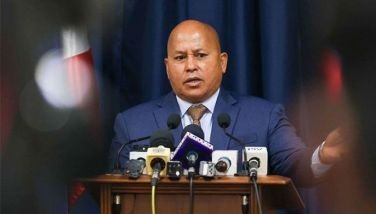NGCP reviewing RE installation targets
MANILA, Philippines - The National Grid Corp. of the Philippines (NGCP) has rejected allegations that it is limiting the installation targets of renewable energy resources.
In a statement, the system operator and transmission service provider said its interim report presented to the Department of Energy last year is not yet a final recommendation on the installation targets.
“The main objective of the research was to help ensure the reliability, quality and security of the power network even with the entry of intermittent renewable energy sources and technologies into the dispatch program of NGCP,” said company spokesperson Cynthia P. Alabanza.
Last year, NGCP and its partners from the State Grid Corp. of China and China Electric Power Research Institute studied how to guard the grid against the effects of the unpredictable nature of intermittent renewable energy.
“We focused on the technical requirements for the levels of intermittent capacities that can penetrate the power system at any given time, without compromising the condition of the entire network,” Alabanza said.
The study’s technical considerations included the electric power system stability and actual available ancillary service under present regulation, NGCP said.
Under Republic Act 9513 or the Renewable Energy Act of 2008, the following renewable energy sources are considered intermittent: wind, solar, run-of-river hydro and ocean energy.
“Renewable energy generating units are powered by location-specific energy sources, which make the availability of generated capacity inherently variable, erratic, and uncontrollable,” NGCP said.
The DOE, for its part, already approved a 760-megawatt (MW) installation target for renewable energy projects. It is composed of 250 MW each for hydroelectricity and biomass, 200 MW for wind power, 50 MW for solar energy and 10 MW for ocean technology.
But renewable energy proponents and advocates are pushing for a higher cap that will allow green energy projects’ output to be transmitted in the grid.
Alabanza said the assumptions on the integration level are still dependent on the availability and sufficiency of regulating reserves.
“The said capacities may be increased only if additional regulating reserve will be made available,” NGCP said.
The Renewable Energy Act mandates the establishment of a feed-in tariff for qualified renewable energy projects.
The feed-in tariff scheme, whose implementation is already delayed by almost three years, guarantees investments of renewable energy firms through fixed rates that would be shouldered by consumers over a set period of time.
Proposed FIT rates are P7 per kilowatt-hour (kwh) for biomass, P17.65 per kwh for ocean technology, P17.95 per kwh for solar power, P6.15 per kwh for run-of-river hydropower and P10.37 per kwh for wind power. The rates are estimated to add roughly P0.12 per kwh to consumers’ electricity bills.
To date, the Philippines sources 35 percent its total power requirements from renewable energy sources.
- Latest
- Trending
































